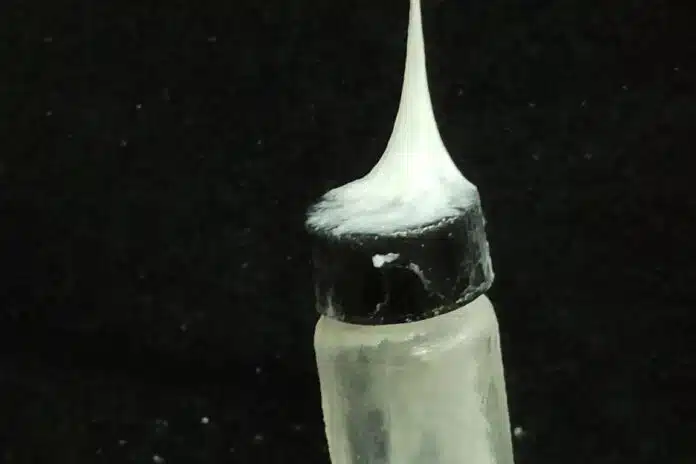
By Ashwini Sakharkar 11 Oct, 2024
Collected at: https://www.techexplorist.com/researchers-create-first-web-slinging-technology-inspired-spider-man/91067/
Every child who has ever dreamt of being a superhero has imagined what it would be like to shoot webs from their wrists, swing through the city, and catch villains in their tracks. At Tufts University, researchers have transformed these childhood fantasies into reality by developing web-slinging technology. This innovative invention allows a fluid material to be shot from a needle, solidify into a string, and adhere to and lift objects.
These remarkable sticky fibers, crafted at the Tufts University Silklab, are derived from silk moth cocoons. By boiling the cocoons in a solution and breaking them down into their fundamental proteins, known as fibroin, the researchers have created a solution that can be extruded through narrow bore needles to form a stream. With the right additives, this stream solidifies into a fiber upon exposure to air, opening up a world of possibilities for this incredible new technology.
Nature serves as the original muse for harnessing the potential of silk fibers, evident in the intricate webs, tethers, and cocoons woven by spiders, ants, wasps, bees, butterflies, moths, beetles, and even flies at various stages of their life cycle. Drawing inspiration from nature, Silklab has embarked on pioneering the use of silk fibroin to create a range of groundbreaking innovations.
These include powerful underwater adhesives, printable sensors adaptable to any surface, edible coatings that prolong the freshness of produce, and light-capturing materials poised to revolutionize solar cell efficiency. Additionally, they are exploring more sustainable methods for microchip manufacturing.
Despite these remarkable advancements in silk-based materials, the researchers have yet to fully replicate the exceptional mastery exhibited by spiders. Spiders possess the remarkable ability to control the stiffness, elasticity, and adhesive properties of the threads they spin, a feat that continues to elude even the most cutting-edge scientific endeavors.
The remarkable properties of silk fibroin solutions never cease to amaze. When exposed to organic solvents like ethanol or acetone, they slowly transform into a semi-solid hydrogel over the course of hours. However, with the introduction of dopamine, the solidification process is accelerated, almost instantaneously forming a strong and sticky material.
This breakthrough paves the way for the creation of fibers with exceptional tensile strength, thanks to the rapid solidification process when the organic solvent wash is mixed in. By leveraging the chemistry used by barnacles to form tenacious fibers that adhere firmly to surfaces, dopamine and its polymers play a crucial role in this transformative process.
But that’s not all. The innovation continues as the researchers take the next step, spinning the fibers in the air. By adding dopamine to the silk fibroin solution, the transition from liquid to solid is accelerated, as the dopamine pulls water away from the silk. When the silk solution is shot through a coaxial needle, the surrounding layer of acetone triggers rapid solidification as the acetone evaporates in mid-air, leaving a fiber firmly attached to any object it comes in contact with.
To further enhance the properties of the silk fibroin-dopamine solution, the researchers introduced chitosan, a derivative of insect exoskeletons, which resulted in fibers with up to 200 times greater tensile strength. Additionally, the incorporation of borate buffer increased the adhesiveness of the fibers by a remarkable 18-fold. This captivating advancement in material science holds great promise for a wide range of applications. The diameter of the fibers can be adjusted to be as thin as human hair or as thick as half a millimeter, depending on the needle’s bore size.
This incredible device can shoot fibers that are capable of lifting objects over 80 times their own weight in various conditions. The researchers showcased this remarkable capability by using the fibers to pick up a cocoon, a steel bolt, a laboratory tube floating on water, a scalpel partially buried in sand, and a wood block from a distance of about 12 centimeters.
Marco Lo Presti, research assistant professor at Tufts, noted that “if you look at nature, you will find that spiders cannot shoot their web. They usually spin the silk out of their gland, physically contact a surface, and draw out the lines to construct their webs. We are demonstrating a way to shoot a fiber from a device and then adhere to and pick up an object from a distance. Rather than presenting this work as a bio-inspired material, it’s really a superhero-inspired material.”
While natural spider silk is currently about 1000 times stronger than the human-made fibers in this study, with a touch of creativity and advanced engineering, the possibilities for improvement are endless. This innovation is set to revolutionize a wide range of technological applications.
“As scientists and engineers, we navigate the boundary between imagination and practice. That’s where all the magic happens,” said Fiorenzo Omenetto, Frank C. Doble Professor of Engineering at Tufts University and director of the Silklab. “We can be inspired by nature. We can be inspired by comics and science fiction. In this case, we wanted to reverse engineer our silk material to behave the way nature originally designed it and comic book writers imagined it.”
Journal reference:
- Marco Lo Presti, Marina Portoghese, Gianluca M. Farinola, Fiorenzo G. Omenetto. Dynamic Adhesive Fibers for Remote Capturing of Objects. Advanced Functional Materials, 2024; DOI: 10.1002/adfm.202414219

Leave a Reply